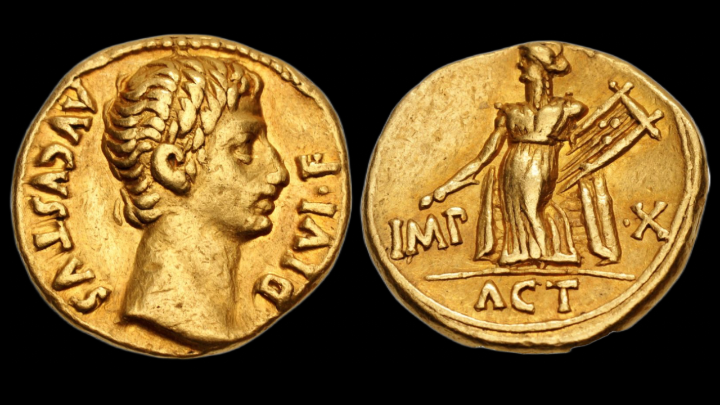In the world of Roman numismatics, few coins manage to combine political power, aesthetic finesse, and symbolic depth as seamlessly as the aureus of Augustus struck in Lugdunum (modern-day Lyon) in 15 BC, featuring Apollo Citharoedus on the reverse. This coin perfectly embodies the restored stability after years of civil war and reflects Augustus’ ambition to bring back order and harmony through Rome’s cultural and spiritual values.
Highly sought after by collectors of the Augustan period, this aureus offers far more than a portrait. It delivers an imperial message in gold, where politics, music, and divinity merge into a powerful narrative.
An Aureus of Augustus: Tranquil Strength and Divine Harmony
Struck in Lugdunum in 15 BC, this aureus is composed of gold, weighs 7.64 g, and measures 18.5 mm in diameter, with a die axis of 8 o’clock. While it shows minor marks and a few faint scratches on the reverse, it retains an excellent level of detail, enhanced by a natural golden toning that adds elegance to its overall presentation.
🔸 Obverse:
The obverse features a bareheaded portrait of Augustus facing right, notable for its refined simplicity and stylistic restraint. Without crown, armor, or drapery, Augustus appears as a modest and peace-bringing princeps, distancing himself from the image of a military dictator. This deliberate artistic choice reflects the gentle transition from Republic to Empire, a core element of Augustan ideology.
🔸 Reverse:
The reverse depicts Apollo Citharoedus, standing left, draped, holding a lyre in one hand and a plectrum in the other. As the god of music, light, order, and peace, Apollo symbolizes the very values Augustus aimed to promote across the Empire.
The selection of Apollo in this peaceful, artistic form is no coincidence. Apollo was Augustus’ personal patron deity, and the emperor had even dedicated a grand temple to him on the Palatine Hill. By portraying Apollo as a musician rather than an archer or solar deity, Augustus emphasized the pacifying, civilizing mission of his reign, which sought to revive Rome not only politically, but also artistically, morally, and religiously.

Augustus, Apollo, and the Refounding of Rome
By 15 BC, when this aureus was struck, Augustus had firmly consolidated his power, having brought an end to decades of bloody civil strife. Coinage became a central tool of imperial communication, with each type carefully selected to reinforce the narrative of restored order and divine harmony.
The choice of Apollo Citharoedus as the reverse motif was a calculated political statement. It symbolized one of the cornerstones of Augustan propaganda: peace achieved through cultural order, not through force. This imagery complemented the portrayal of Augustus as both ruler of the world and servant of the gods, guardian of the Pax Romana and protector of the arts.
Moreover, by minting this aureus in Lugdunum, a newly established imperial mint in Gaul, Augustus signaled the integration of the provinces into the imperial system, while also reinforcing the universal reach of his regime.
An Exceptional Coin for the Finest Collections
This aureus of Augustus with Apollo Citharoedus is far more than a gold coin: it is a manifesto of peace, culture, and imperial unity. Its rarity, elegance, and deep symbolism make it a coveted masterpiece among collectors worldwide.
This particular specimen comes from the Libertas Collection, previously part of the A. J. Donald Collection, purchased from Spink in May 1946. It was sold for $11,000.
📩 If you are searching for this coin — or another exceptional piece — just ask us. At AV Janus, we will find it for you.